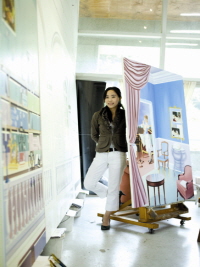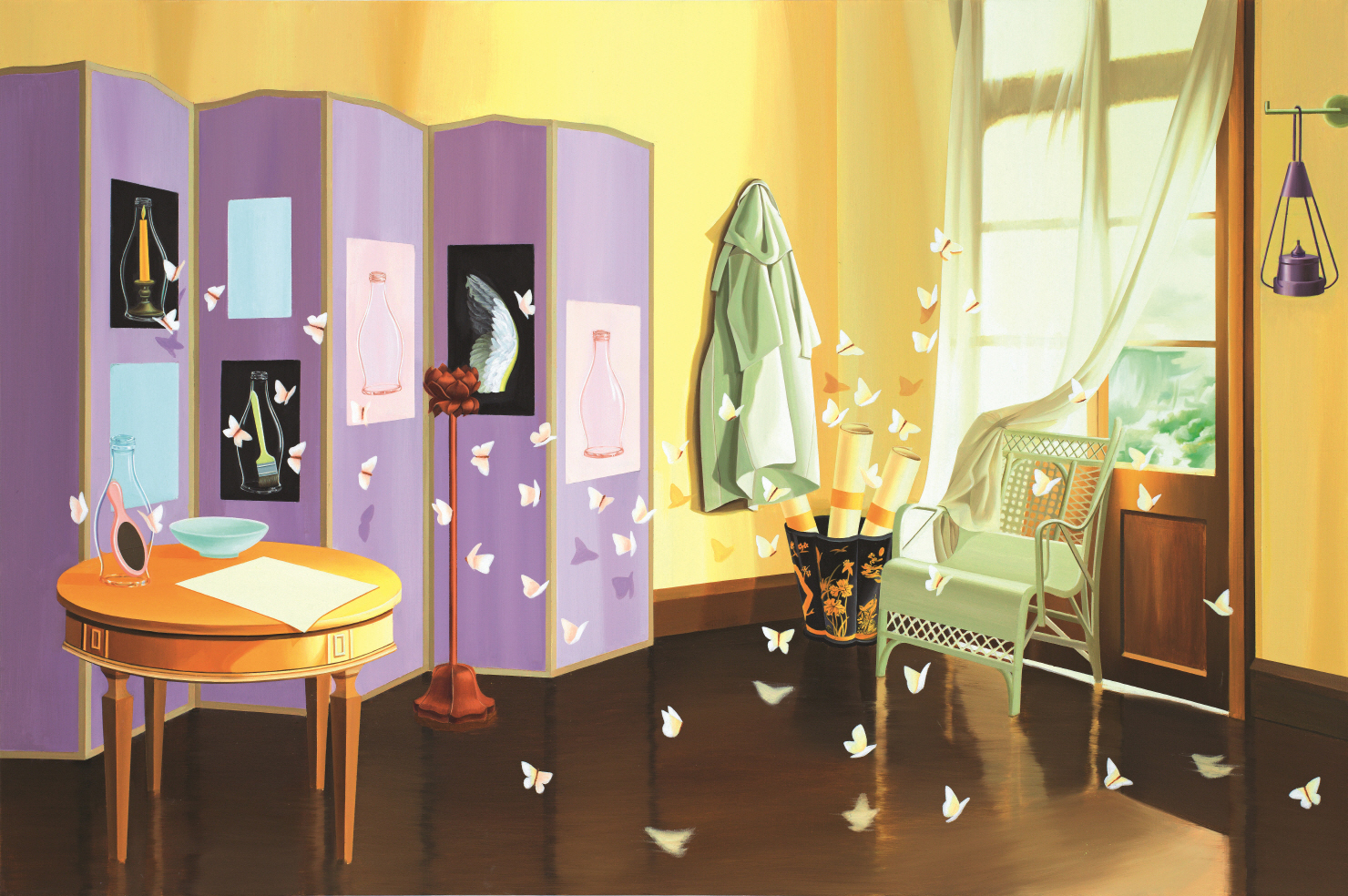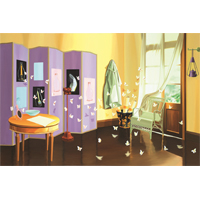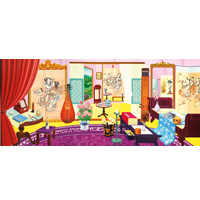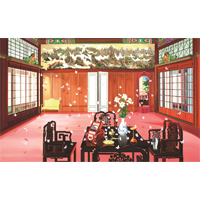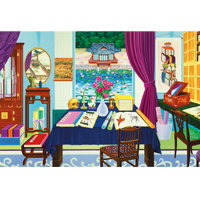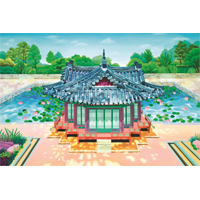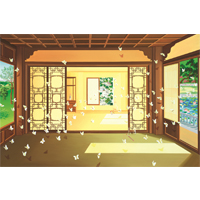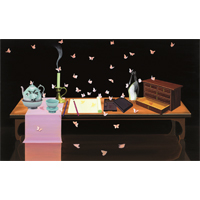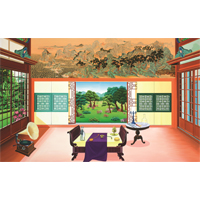Kyungmin NAM's Paintings-Masters invited to a feast of painting
An artist's studio is a crucible of creation and originality. An artist is in complete solitude in her studio. In order to enter a different reality and to open another world, the artist alienates herself from the sensuous reality. Having separated herself from this world, the artist becomes an illusionist dreaming her dream, an alchemist transforming matter, and a fixer who repairs the world. Such work requires reclusion from the phenomenal world, that is, to internalize a sense of absence. Thomas Mann said art is something that rises above absence. In other words, there is no art if there is no absence. Then, how can absence be found? Nietzsche said when a mouse is driven into a corner it hides itself inside itself. It is to drive herself to the extreme edges of the world as we know it and encounter another herself who may be her true self. Well, herself to be encountered this way may feel strange and unfamiliar to her. The inner self is the only world that the logic of the mundane world cannot reach, and it can be a strange unknown world even to the subject. It (one’s inner self) is a world where the meanings of things and phenomena can be determined and changed to one’s content, open to unlimited and eternal potential, and a non-deterministic world. Absence is, thus, hidden in one's inner world, and from this inner world opens another world. Heidegger said that art is opening of a world, that is, opening of another world unlike the world of sensuous reality. The subject of creation who isolated herself from reality and has hidden herself in her own inner world gets an opportunity to open another world from there.
Namkyung Min is curious about artists who have opened new worlds this way and their studios. For this reason, Nam invites artists and their studios into her paintings. She collects materials relating to studios of the artists, and then reproduces their studios based on those materials. Sometimes, she uses archival materials like photos, and other times, images in pictures as sources for her paintings. Nam does not depict studios of masters as they are. Ordinarily, by undergoing a process of borrowing, editing, and reconstructing partial images, and typical iconography and semiotics, she overlaps a master's studio on a symbolic space created by the concept of the artist herself. This overlapping is so close that the viewers cannot separate the master's studio from the artist's conceptual space. Perhaps this overlapping can be seen as a concept coming into confluence with another concept rather than a relation between one studio and another studio, that is, a master's conceptual space and the artist's conceptual space are interwoven into a fabric. Such interwoven space is opened as the third place, and it is space which does not strictly belong to either the artist or the master. This third place and space should be the ultimate destination toward which Nam Kyung Min's painting aspires. Nam intends to metaphorically mark the geopolitical coordinates on the map of painting. Her process recalls Gadamer's "Fusion of Horizons." In other words, the horizon of a master (the other) and I (the subject) are fused into one to open a third horizon. With this newly opened horizon as a medium, the master and I come to exchange and interact, and by doing so, the master is absorbed as a part of my personality. In order to realize such close exchange, Nam invites great painters into her painting: Cezanne and Mondrian, who dreamed of a world of pure geometric forms; Vermeer and Monet, who opened new horizon of painting with velvety gentle light texture and optical light; van Gogh, symbol of emotionalism and pathos; Modigliani imparting melancholy with a long neck and sad eyes; Moreau, master of mystical symbolist art; Magritte, who held conceptual art by alchemy of language and symbol as medium; Hockney, a pop artist who referred to his homosexuality in his work; Frida Kahlo, a revolutionary artist who reflected her personal traumas in her work; Matisse, an optimist who wanted to do paintings as inviting as an easy-chair (nevertheless, it is ironic that he is dubbed the leader of Fauvism); and Richter, who crisscrossed abstract and figurative arts and blurred the boundaries between painting and photography.
But where are all those masters she has invited in her painting? We see neither the masters nor the host (the artist herself) in any of her paintings. There are only empty chairs around the table. The masters are referenced in typical iconography and symbols of their own, and the artist herself is presented by the capital letter N. Strictly speaking, even the letter N appears in the title, rather than in the painting itself. A kind of counterpoint and painting style characterized by omission which places iconography and symbolism on par with masters are used. By omitting, Nam creates suggestive spaces. Then, she can afford to fill each of the spaces with its own imagination, and can have excuses to find links between yet unknown meanings. Masters granted, where is the artist? Butterflies flying in the canvas are the artist herself. The artist who became butterflies visits studios of masters transcending space-time and invites them to her studio. While admitting that the artist was transformed into butterflies, the butterflies themselves are unrealistic. They are flapping wings as if dreaming, and they look as if messengers of unreality who crossed into reality from the other side of reality.
A window and mirror reflect images which often appear in Nam's paintings and add a sense of unreality to her paintings all the more. Reflected images were important to the origin of painting, and Nam uses reflected images in her paintings to create a kind of painterly maze. A mirror is reflected on a window; then the window is reflected on the floor; and the floor is reflected in the mirror. With a reflected image reflecting another reflected image over and again, a reflection invites another reflection, which seems to continue endlessly, and a painterly maze is created. Speaking with slight exaggeration, I wonder if there is any motif which is drawn as it is without being reflected at all in her painting. Even if there is, its meaning is buried inside the meaning of the reflected image. All the spaces and motifs appearing in Nam's paintings seem like reflected images. Of course, reflected images are images that re-reflect reality. They are neither reality itself nor reproduction of reality. She did not use tricks or distort anything intentionally. Even so, reality in her painting has lost the sense of reality and feels out of place. This is why butterflies fly while flapping their wings in unrealistic space as if they are dreaming. Maybe such unrealistic space is the artist's conceptual space. Nam has rendered conceptual space rather than real space. She has drawn conceptual circumstances. Her painting in the future opens to a kind of virtual play and illusionary game where masters (the others) and the artist (subject) meet; the past and the present overlap; and the boundaries of reality and virtual are blurred.
Chung-Hwan KHO (Art Critic)
more
Walking on the Mindscape - Paintings of Kyungmin NAM
Since her solo exhibition in 2005 until now, Nam Kyungmin has continued to paint indoor landscapes, which include artists' studios, butterfly collections and study series. The most important fact in Nam's paintings is that it is not actual landscapes expressed on the picture-plane, but an invisible domain that was created by them. The unreal landscapes that overlaps on top of the actual landscapes is, to quote the artist, a "mind scape," and a world of "meta reality," which transcends all ideas about the phenomenal world.
Though indoor objects such as tables, chairs, beds, bookcases, windows and mirrors are painted on a picture-plane of vivid colors, the reason her picture-planes do not seem friendly but come to us with a certain strangeness or with a nuance of alienation or solitude is because of the peculiar dual structure of the picture-plane, which consists of many layers of time-space, the objects that accompany symbolism and allegory, and most of all, the tension given by absence and silence.
Though indoor objects such as tables, chairs, beds, bookcases, windows and mirrors are painted on a picture-plane of vivid colors, the reason her picture-planes do not seem friendly but come to us with a certain strangeness or with a nuance of alienation or solitude is because of the peculiar dual structure of the picture-plane, which consists of many layers of time-space, the objects that accompany symbolism and allegory, and most of all, the tension given by absence and silence.
Homage to the Masters, Landscape as Absence
The significance as absence is valid in the "Artist's Studio" and "Artist's Room" as well. These representative series of Nam Kyungmin's paintings are based on awe toward classics and art historical text, and homage to masters, who gave her inspiration. From the Renaissance to the 20th century, original texts of art history have been the archive and storage place for Nam's references and quotes. The recomposition of the masters' studios in a series of paintings begins from interest and aspiration for the creative spaces of the masters, where they faced themselves in a strictly isolated state, and where pain, pleasure, solitude and instability intersected. The reason the rooms and studios of the artists look like psychological landscapes of absence, silence, and loneliness could be because the alienation and solitude felt as an artist were transferred to the workspaces of the late masters, but rather it is because the artist's studio is a symbol of absence itself. As the belongings of the dead evoke his/her presence even more strongly, the empty beds and chairs in Rembrandt's Red Bedroom, Memory of van Gogh, and Frida's Bedroom strengthen their existences and absences. The butterflies that fly around in the artists' spaces are de-materialized souls or creative energy of the artists, which are illusions of the beings do not exist today. Nam Kyung-Min did not intend to present the artists' studios iconographically, but seems to have wanted to suggest the absence, or reveal the invisible, through her works, and express her inner world.
What enables us to perceive whose studio or room it is, is the works, objects and the overall atmosphere, which is in code and requires further interpretation compared to the previous works. In Picasso or Memory of van Gogh, there are no images of the artists' works to serve as certain alibis to confirm that the spaces are in fact the studios of the artists. In Picasso the spiral stairway that stretches up together with the artist's rear view reminds us of the father of modernism Picasso, who signifies Utopia as progress, and in Memory of van Gogh, van Gogh summons his short life as an uncompleted artist with wings confined in a bottle and a blown out candle. Recently, Nam has been recomposing the existence of artist from a dimension of symbolism and paradox. In Nam Kyungmin's paintings, the method of homage to masters reaches its peak in the study series such as From Manet to Warhol and Roaming in a Baroque Study, and Artists' Banquet, which re-interprets Leonardo da Vinci's Last Supper. In the study series, the artist juxtaposes books with the names of Impressionist masters such as Manet, Degas, Cezanne and Seurat, and Baroque masters such as Vermeer, Velasquez, Caravaggio and Rembrandt with art works and symbolic objects to maximize her awe toward classics. In the Artists' Banquet, the existence of twelve artists revered by Nam?Jan van Eyck, Velasquez, Rembrandt, Vermeer, Manet, Cezanne, Monet, van Gogh, Matisse, Picasso, Magritte and Hockney?is replaced by chairs, while the Holy Communion is replaced by objects that symbolize the masters, forming a link between Nam and the masters.
What enables us to perceive whose studio or room it is, is the works, objects and the overall atmosphere, which is in code and requires further interpretation compared to the previous works. In Picasso or Memory of van Gogh, there are no images of the artists' works to serve as certain alibis to confirm that the spaces are in fact the studios of the artists. In Picasso the spiral stairway that stretches up together with the artist's rear view reminds us of the father of modernism Picasso, who signifies Utopia as progress, and in Memory of van Gogh, van Gogh summons his short life as an uncompleted artist with wings confined in a bottle and a blown out candle. Recently, Nam has been recomposing the existence of artist from a dimension of symbolism and paradox. In Nam Kyungmin's paintings, the method of homage to masters reaches its peak in the study series such as From Manet to Warhol and Roaming in a Baroque Study, and Artists' Banquet, which re-interprets Leonardo da Vinci's Last Supper. In the study series, the artist juxtaposes books with the names of Impressionist masters such as Manet, Degas, Cezanne and Seurat, and Baroque masters such as Vermeer, Velasquez, Caravaggio and Rembrandt with art works and symbolic objects to maximize her awe toward classics. In the Artists' Banquet, the existence of twelve artists revered by Nam?Jan van Eyck, Velasquez, Rembrandt, Vermeer, Manet, Cezanne, Monet, van Gogh, Matisse, Picasso, Magritte and Hockney?is replaced by chairs, while the Holy Communion is replaced by objects that symbolize the masters, forming a link between Nam and the masters.
Spaces of Symbolism and Allegory
Nam Kyungmin's inner landscapes show numerous repeated objects that trigger iconographical interpretation. The objects that appear in Nam's paintings as visual archives, such as skulls, hourglasses, blown out candles, wings, butterflies, lilies and transparent bottles, not only have symbolic connotations, but also reveal multiple meanings that transform the works into complex and multi-layer mutual textual spaces. Furthermore, her objects refer to each other and cause association to lead spectators to free flow of consciousness. The objects of Nam Kyungmin's paintings, characterized by single and decisive absence of signifiant based on a context of duality, transform normal inner landscapes into complex space of allegory. The allegorical rhetoric, which penetrates a different meaning in a given meaning, is revealed in the butterflies that float throughout the spaces such as the studios, indoors and studies. In Rembrandt's Bedroom the butterfly is a metaphor of the artist's soul, and of the illusion of painting. In the "Artist's Studio" series, the butterfly is the feeble and delicate artistic disposition, and the flow of artists' self-consciousness. It is a brilliant flight but a lonely and wretched state, and it is hope but an unstable scar. Sometimes the butterfly, which even triggers crudeness and fear in the empty indoor landscape, acts as a powerful mechanism of crossing over the border between reality and non reality, while it maintains an endlessly transforming rhetoric state.
While the butterflies in Nam's paintings illustrate the dually overlapping parts where dream and reality intersect, as in the "butterflies of Chuang-tzu", the skull is a dualistic rhetoric of life and death. The skull carries dual significance as it is both death, which is the peak of vanity, and also holiness. In Nam's paintings, the candle travels between existence and non-existence through the state of burning and blown out, while the wings reveal the two sides of desire for flight and endless fall as in those of Icarus. The hourglass symbolizes the flow and stop of time, and the limit of life. The lily symbolizes pureness and truthfulness. The transparent bottle is the essence of unchangeable truth, but also shares the duality called weakness due to its easily breakable nature. The Jesus statue, which appears from time to time is "God" as a seeker of truth, but also a "human" with internal sadness.
The objects in Nam Kyungmin's paintings carry codes of death and loss as in the skulls, candles and wings, but also evoke philosophical epistemology such as life and death, or existence and time. Perhaps this is why her paintings are filled with "sensuous" colors, but also open a space for "thought."
Such objects, filled with non-decisive and dual significances, overlap in a single picture-plane or interconnect like a chain, preventing clear comprehension of Nam's paintings. As Annunciation 1- Invitation, in which candles, skulls, wings and lilies harmonize with scenes of the Annunciation and banishment from Eden, postponed clear interpretation of spectators, Nam Kyungmin's paintings create fundamentally undecipherable narratives or allegories like a "copy of continuously overwritten parchment." Before her paintings that travel between metaphor and metonymy, spectators conceptually participate in an intellectual game to decipher the coded message, and happily experience the poetic associations.
Dual Structure of Nam Kyungmin's Paintings, in which Time-Space Overlaps ? Realm that Cannot be Signified through Language
Nam Kyungmin's paintings maintain a peculiar dual structure, in which the inside and outside communicate through windows and doors, and various time-spaces overlap in a single picture-plane. Though they are actuall in the foreground, the curtains, windows, mirrors and stairs assume a different space and extend existing limited space. The curtains and doors painted in the beginning of Nam's indoor landscapes are certain borders or thresholds that enable one to travel to another time-space, which enables us to assume the existence of spectators looking at the picture-plane from outside. By doing so, many layers of time-space, such as the space in front of the curtains, the inner space beyond the curtains, the space outside the window, and the space inside the mirror, can be overlapped on the picture-plane. For example, the curtains and spiral stairs in Picasso mix up the utopian time-space of the future, suggested by the position of the spectator(artist), Picasso's studio space, and the spiral stairs, nullifying the consistency of time-space.
Thus the windows and doors as passages between the inner space and outer space in Nam's paintings are not geographical borders, but rather points where physical space and psychological space meet, or a transparent screen that enables free flow of consciousness. Especially, the windows opening to the outside are passages that open the present concealed world to the outside. This is consistent with the ideals of painting, which intends to open another world in a given world. As if to reflect this, in her paintings the windows overlap with the paintings. This window and painting facing outward is a window towards the reality sought by painting, ever since the Renaissance period, which visualizes the ideal world on the other side of reality that makes us thirsty and longing. In addition to windows another element that recomposes perceptive space is the mirror. Especially the reflected images in mirrors and windows distort the existing visual structure we are used to, and dismantle the unity of perceptive space and consistency of time-space. For example, in Three Chairs, a chair is reflected twice and three-fold in a mirror to implicate heterogeneous time-space and push space deep into the mirror. In Mondrian's Studio, the mirror in the front reflects the scenes before the mirror exactly, but makes it obscure whether the reflection is from outside the mirror, belongs to the inside of the mirror, or is painted on the surface of the mirror. In the mirror of Annunciation 2, the angle is eliminated from the reflection, and in Rest- Entering a Baroque Mirror, the mirror reflects objects from the same surface and the mirror, instead of objects in front of it. In Nam's paintings we can tell that the reflected images in the mirrors coincide with the objects, but strangely run against them. Perhaps it is because of such peculiar picture-plane structure, which shakes the center of stable perception, that her paintings are accompanied by unknown instability and strangeness.
Such strange instability is sensed in Annunciation 2, Artist's Butterfly Collection and Sad Beauty is Beautiful, which use classic-style interiors as backgrounds. The artist summons a museum, which preserves the past, an arch-shaped classical architectural structure, an angle from the Annunciation, classical structures, and other old things to a point in the present. Such things, which have been familiar from long ago, are no longer familiar. They now present inner tension and a strange fear like before a storm due to archaic stillness and the movement of butterflies that shake it, and the subtle intersection of light and darkness. The perspective mechanism, which amplifies the level of uneasiness and tension, strengthens such uncanny sentiment of friendliness and strangeness closely encountering.
Though Nam's paintings borrow images from the familiar masters in the form of homage, they evoke not generally uniform symbols, but a realm that exists outside clear language, and cannot be signified in language. This was possible because of the allegorical effect of the objects with overlapping meanings, and the peculiar space structure that scrambles stable perception. Her paintings are mysterious and illegible, but are a world of punctum, which stabs our peaceful consciousness. Perhaps Nam Kyungmin's paintings, which are in gear but mutually counter at the same time, are in the place of the "window"?her subject of attention. This place is the border between inside and out, the border between the visual and the linguistic, the border between consciousness and unconsciousness, and the border between reality and the heart. It is at that border that our consciousness cracks and the boundary of perception is expanded. Perhaps that is when we can properly ramble in and absorb the inner world, the landscape of the heart.
Thus the windows and doors as passages between the inner space and outer space in Nam's paintings are not geographical borders, but rather points where physical space and psychological space meet, or a transparent screen that enables free flow of consciousness. Especially, the windows opening to the outside are passages that open the present concealed world to the outside. This is consistent with the ideals of painting, which intends to open another world in a given world. As if to reflect this, in her paintings the windows overlap with the paintings. This window and painting facing outward is a window towards the reality sought by painting, ever since the Renaissance period, which visualizes the ideal world on the other side of reality that makes us thirsty and longing. In addition to windows another element that recomposes perceptive space is the mirror. Especially the reflected images in mirrors and windows distort the existing visual structure we are used to, and dismantle the unity of perceptive space and consistency of time-space. For example, in Three Chairs, a chair is reflected twice and three-fold in a mirror to implicate heterogeneous time-space and push space deep into the mirror. In Mondrian's Studio, the mirror in the front reflects the scenes before the mirror exactly, but makes it obscure whether the reflection is from outside the mirror, belongs to the inside of the mirror, or is painted on the surface of the mirror. In the mirror of Annunciation 2, the angle is eliminated from the reflection, and in Rest- Entering a Baroque Mirror, the mirror reflects objects from the same surface and the mirror, instead of objects in front of it. In Nam's paintings we can tell that the reflected images in the mirrors coincide with the objects, but strangely run against them. Perhaps it is because of such peculiar picture-plane structure, which shakes the center of stable perception, that her paintings are accompanied by unknown instability and strangeness.
Such strange instability is sensed in Annunciation 2, Artist's Butterfly Collection and Sad Beauty is Beautiful, which use classic-style interiors as backgrounds. The artist summons a museum, which preserves the past, an arch-shaped classical architectural structure, an angle from the Annunciation, classical structures, and other old things to a point in the present. Such things, which have been familiar from long ago, are no longer familiar. They now present inner tension and a strange fear like before a storm due to archaic stillness and the movement of butterflies that shake it, and the subtle intersection of light and darkness. The perspective mechanism, which amplifies the level of uneasiness and tension, strengthens such uncanny sentiment of friendliness and strangeness closely encountering.
Though Nam's paintings borrow images from the familiar masters in the form of homage, they evoke not generally uniform symbols, but a realm that exists outside clear language, and cannot be signified in language. This was possible because of the allegorical effect of the objects with overlapping meanings, and the peculiar space structure that scrambles stable perception. Her paintings are mysterious and illegible, but are a world of punctum, which stabs our peaceful consciousness. Perhaps Nam Kyungmin's paintings, which are in gear but mutually counter at the same time, are in the place of the "window"?her subject of attention. This place is the border between inside and out, the border between the visual and the linguistic, the border between consciousness and unconsciousness, and the border between reality and the heart. It is at that border that our consciousness cracks and the boundary of perception is expanded. Perhaps that is when we can properly ramble in and absorb the inner world, the landscape of the heart.
Myung-Ji BAE (Chief Curator, Koreana Museum of Art)
more






